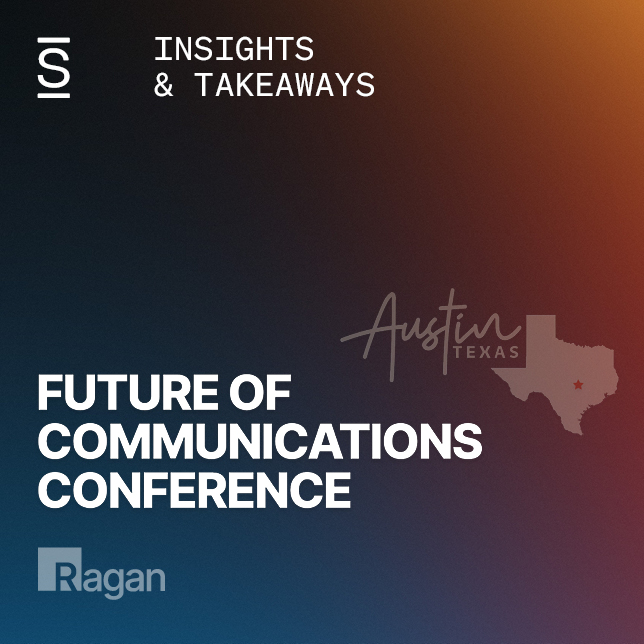Our workplaces and spaces have changed in the years following the pandemic, with workers more distributed than ever. In 2020 and 2021, the focus was on “getting back to normal,” followed by a push to overcome and adapt to a new normal. This transition will stay with us for years as organizations strive to create a cohesive and inclusive workplace.
But how do you keep remote, deskless, and in-office employees connected and engaged so they can simply flourish™? It hinges on a dynamic communication strategy and how an organization communicates with its employees—and it has many moving parts.
Connecting these communication dots that make up the employee experience, we find Jill Stracko, director of communications at Cruise, a leading autonomous vehicle company. She joined with Amanda Berry, Manager of Corporate Brand & Communications at Simpplr, to discuss the vital role internal comms plays in supporting this effort and ways to navigate these new employee experience waters in episode 13 of the Simpplr Cohesion Podcast.

Principles of internal communications
Jill Stracko is no stranger to internal communications (IC). Her career has taken her to Silicon Valley and Washington, D.C. She led President Barack Obama’s writing team in the White House and served as senior legislative correspondent to then-senator Joe Biden. Her varied experiences have naturally influenced how she views IC and its role in employee experience.
“You want people always to be reminded of why they came to work at this company and why it’s amazing.” And this aligns with three principles Jill finds imperative for any organization’s IC function. They include informing and inspiring, connecting disparate parts, and exclusivity. We’ll detail each below.
Informing and inspiring
When employees understand what’s going on in the company and how decisions are made, their jobs make sense, making the work easier to do. Employees feel like they’re part of things and are invested.
For example, showcasing company stories, such as the innovations happening around the company, reminds employees of why they chose this job and why they chose it each day. As a result, they can see the bigger picture and their place in it. Discover our internal newsletter ideas to help keep your employees engaged.
Connecting disparate parts
The second principle is all about connecting the many working parts of your company—from top to bottom and creating one cohesive culture.
The IC team wears many hats, and one overlooked role is leadership helping leadership. IC helps employees stay aligned with the company and keeps leadership aware of employee achievements and how their day-to-day work supports the company’s strategy, priorities, and overall mission and values.
A simple message of gratitude from leadership can prove inspirational to employees who may feel disconnected from the whole. Most workers like to know how they’re doing and crave some form of encouragement. It attaches value to their work, generates pride in working for a company that recognizes their efforts, and enhances employee experience.
Exclusivity
The internal communications team differs from external communications, and its informational offerings should reflect this. For example, IC should offer intel that only insiders, i.e., employees, can access—meaning insight that is not publicly available on the company blog or via a press release.
Employees should view themselves as insiders who are part of something great because they are.
External comms and messaging is another animal, bringing us to PR and how it must ultimately align with internal messaging.
Aligning internal comms with PR
Sometimes PR forgets about internal communications and just barrels ahead. This can be disastrous as company values and messaging need to be consistent across the board. Creating a working relationship between PR and internal comms keeps things aligned, of course—but it’s easier said than done.
Fortunately for listeners, Jill shared strategies for bridging the communication gap between PR and internal comms, including creating opportunities to connect and creating an “internal comms road show.” These events showcase different departments or regional team activities to help PR understand the organization’s inner workings and where IC fits in the mix.
These exclusive presentations prop up employees for recognition and generate what Jill calls a “virtuous cycle” where you create excitement with different teams ahead of external announcements. And that excitement benefits everyone.

This also helps position IC as a channel for building a pipeline of spokespeople who can cut their teeth on internal presentations and build confidence to share insight with larger audiences, even potential customers. And facilitating this communication and engagement between teams creates a cohesive culture while positioning IC as a go-to for PR when they have operational questions.
This alignment is crucial when more than half of your team works remotely.
Keeping remote workers aligned
Keeping remote workers aligned and engaged poses various challenges, but Jill and her team have worked out creative ways to approach this issue.
Getting an employee’s undivided attention takes a lot of work. During online meetings, one employee may have a toddler meandering around, another may have dogs barking, or another may be experiencing a power outage on their block. These human experiences are par for the course in our remote work world, and meetings must adapt.
Jill found that having hour-long all-hands meetings doesn’t work great when competing with background noise. So, she found creative ways to rethink them, including reducing meeting times or having rotating schedules with one week focused on content and the following week offering a Q&A. Her team also started offering Zoom meetings with individual breakout sessions; all recorded so anyone can tune into sessions they didn’t pick later on.
It’s a different way of engaging employees, one that Jill says “doesn’t feel like more of the same,” so ideas keep rolling and discussions are fresh. It’s creating something fun that employees want to be a part of, which requires staying attuned to employee feedback.
Auditing communications and streamlining feedback
A good starting point for internal alignment is auditing your IC efforts. Jill asks questions like:
- What do you want to learn more about?
- Which leaders do you want to hear from more often—or at all?
- Share the channels where you find most of your information, and what channels do you prefer?
- And how would you rate the effectiveness of existing channels, and are there other channels you’d prefer to use that aren’t integrated?
To streamline this process, Jill uses Slack for candid discussions to help employees interact with one another and discuss these things. And she reserves email for communicating more critical information. This helps employees prioritize mission-critical info and allow for some levity on Slack channels, as feedback is essential, but so is staying flexible and having a sense of humor.
It’s important for organizations to have a well-defined employee experience strategy that enables them to pivot and adapt to sudden changes, which is crucial in maintaining momentum. And this is perhaps the biggest challenge to organizations outside of keeping employees aligned—not taking things too seriously, keeping your focus training on connecting those employee experience dots regardless of what’s going on outside. But we’ll leave you to tune into the podcast to see if you agree, as Jill shared so many insightful nuggets to consider.
And if you want to hear more from employee experience trailblazers, subscribe to the Simpplr Cohesion podcast.
















